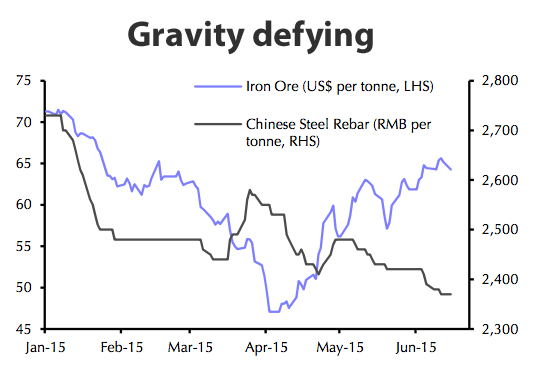
Things are looking gloomy down at the plant
The benchmark 62% Fe import price including freight and insurance at the Chinese port of Tianjin lost $1.20 or 1.9% to $60.90 a tonne according to data provided by The SteelIndex, a two week low.
High grade 65% Fe fines at the port of Qingdao fell back below $70 a tonne, down more than 6% in little over a week.
Benchmark prices are still 30% for the better since hitting record lows at the beginning of April.
The rally in iron ore was fuelled by declining stockpiles in China which consumes more than 70% of the 1.3 billion tonne seaborne trade.
Port stocks have declined for nine weeks in a row falling to its lowest level since late 2013 at 82 million tonnes. That’s down from a peak above 110 million tonnes hit mid-year 2014.
Export disruptions from both ports in Brazil and Australia also acted as price support placing a constraint on iron ore import volumes which fell 12% in May from the previous month.
But Chinese steelmakers drawing on inventories may have been a temporary phenomenon. The FT quotes Morgan Stanley analyst Tom Price as saying the Asian nation’s blast furnaces typically replenish stock of iron between February and May “but because of the uncertain outlook and a tight credit market they waited until the last moment this year”:
“That’s what has driven the market — a delayed restocking event,” says Mr Price. “The mills have no choice. If they don’t produce more steel to meet what’s left of the seasonal peak in demand, they will have to shut down operations,” he adds.
But the clearest sign that the rally in iron ore may have been overdone is the fact that Chinese steel prices kept on falling even as fines prices climbed.
Indeed, the most-traded October rebar contract on the Shanghai Futures Exchange closed at a record low of 2,223 yuan ($362) per tonne on Wednesday.
“Steel prices in China have continued to fall despite the rally in iron ore prices in the last month, limiting the ability for steel mills to pay increasingly higher prices for ore,” Australia and New Zealand Banking Group analysts said in a note quoted by Reuters.
That more low cost supply is coming on stream later this year from Australia – most notably from Gine Rinehart’s new 55 million tonnes per year Roy Hill operation – does not bode well for the iron ore price going forward.
Capital Economics senior commodities economist Caroline Bain has the most devastating assessment of the longer term prospects for the industry:
“Perhaps somewhat ironically, the recent (relative) strength of iron ore prices could be the final nail in the coffin for prices in the longer-term, by encouraging, we think, false hope and higher production.
“This was seen recently as Australia-based Atlas Iron was able to raise financing and restart operations, after being forced to close mines earlier in the year owing to the slump in prices”
Capital Economics’ house view of the iron ore price is a decline to $45 a tonne by the end of the year, more than 25% below today’s price.

Source: Capital Economics
Image by junrong / Shutterstock.com
2 Comments
klgmac
Didn’t Indonesia essentially close down their iron ore exports? Are they still hunkered down?
Chat.ceo.ca/iron
The Iron market is going to be in for a touch ride if Capital Economic’s house is somewhat accurate with their $45 a tonne forecast. The new supply from Gine Rinehart’s 55 million TPD Roy Hill operation doesn’t bode well for the industry either. To hear what resource professionals are saying about the iron market sign up for free at chat.ceo.ca all iron companies publicly listed are in this app and provide free insider trade alerts.